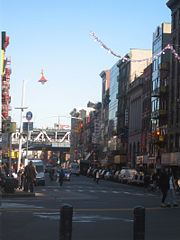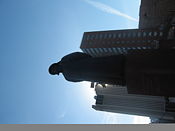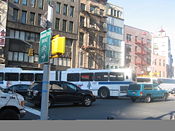Community Issues
From East Broadway, Chinatown
Contents |
History
Tenements
With the immigration boom in the late 19th century the construction of tenement buildings became popular, especially in the Lower East Side. However, these tenement buildings, while creating residential space, caused drastic decreases in available public space and reduced the supply of light and air within those places. In addition, the tenements themselves were extremely limited when it came to basic necessities such as fire escapes, proper plumbing and ventilation, and garbage disposals.
In 1867, the state legislature began to pass a number of Tenement Housing Acts. The First Tenement Housing Act in 1867 required fire escapes and windows. The Second Tenement Housing Act in 1879 required a window to the outside in every room as well as requiring indoor toilets in every building. However, many of these laws were not enforced.
In 1901, another Housing Act was passed known as "The New Law". It reenforced the previous laws requiring proper fire safety devices such as fire escapes, proper light, ventilation and plumbing, and an open courtyard.
The Progressive Era started around this time with a push from Jacob Riis in his book How The Other Half Lives. In it he outlined the lives of many of the new immigrant living in the Lower East Side. One of his main focuses was tenements. He wrote of the cramped and inhumane living and all the diseases going around; namely, smallpox, cholera, and tuberculosis.
Today, tenements still exist to a certain degree. Many immigrants from China arrive with little or no money and huge debts to the people that smuggled them in. In a documentary titled "Snakeheads: The Chinese Mafia and the New Slave Trade", the narrator shows the viewer the current living conditions of many of today's Chinese illegal immigrants with a hidden camera. They often live in a small basement crowded with many two or three tiered bunk beds, where each bed holds about two people. The kitchen consists of a hot plate plugged into the wall and a pot, and the bathroom is practically non-existent. These rooms are called Single Room Occupancy (SRO).
Zoning
East Broadway, along with the rest of New York City, has seen huge changes over the last century. Among those changes, is New York City's move from being residential and industrial to mostly commercial.
1916 Zoning Resolution
As New York became more and more the financial center of the world, huge commercial buildings went up, such as The Equitable Building in the Lower East Side. Government’s solution was the Zoning Resolution of 1916, which put major restrictions on buildings. While it didn’t limit the height, it limited the size of the building as a percentage of the lot. This resulted in many skyscrapers such as the Empire State in 1932.
1961 Zoning Resolution
This resolution needed many amends that finally a new Zoning Resolution came out in 1961. This resolution used incentives for builders to create open public spaces such as plazas. However, because many of the buildings in Chinatown were built before that, East Broadway is cluttered with relatively short, fat buildings.
FDNY
According to an interview done with East Broadway's FDNY, comically dubbed The Chinatown Dragonfighters, revealed that the two main issues the FDNY deals with along E. Brpoadway are Single Room Occupancy (SRO) hazards and traffic accidents along the overcrowded street.
Public Transportation
Private Bus Relocation
Main article(s): Interstate Bus Network
Buses operating out of the Chinatown area have in recent years been subject to more scrupulous inspection. In July 2007, the Lower East Side Community Board heard a recommendation brought by the Transportation Subcommittee that would have the buses relocated. The bus lines have been divided by the Community Board into two groups, with one group consisting of so-called casino buses, that make trips or stop-overs at various casinos, and a second group of interstate tour buses. The casino buses had loaded and unloaded on Division Street between Market Street and the Bowery. The area immediately surrounding the buses contains three schools and a large residential complex. The concern surrounding the buses' effects on surrounding residents has led the Community Board to discuss moving the casino buses to Chatham Square between East Broadway and Catherine Street, further away from the larger residences and schools.
The interstate buses also have faced recommendation for relocation. Many interstate buses load and unload on Forsyth Street between Canal Street and East Broadway, an area that the New York Fire Department has warned should be kept clean of traffic, should the need for quick response arise at the Manhattan Bridge. Others operate at various corners along East Broadway, leading to security issues and fights between bus companies. The Community Board has attempted to unify these buses into one location that would solve these problems.
Both resolutions were sent back to the Transportation Subcommittee for further research, but are expected to pass.
Further Reading
- Medaglia, Angelica "Cigarettes Are Costly, but Often Less So in Chinatown". The New York Times. <September 18, 2007>.


